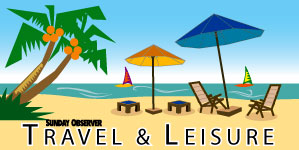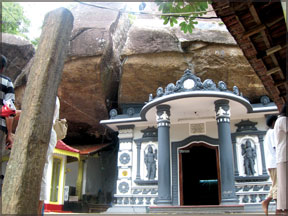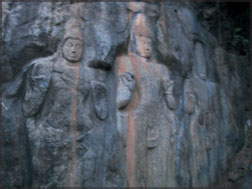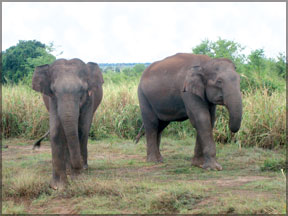Exploring the wild
Nature is man's teacher: a national drive to protect
nature and conserve wildlife:
by Rosanne Koelmeyer Anderson
 As Charles Dickens described "Nature gives to every time and season
some beauties of its own; and from morning to night, as from the cradle
to the grave, is but a succession of changes as gentle and easy that we
can scarcely mark their progress" was the first two- day nature tour
organised by the Zoology Department of the Open University, Nawala last
weekend as a national drive to promote Lassana Sri Lanka's splendorous
diversity of fauna and flora in some of the country's premium
archaeological sites and some of nature's best places of interest. As Charles Dickens described "Nature gives to every time and season
some beauties of its own; and from morning to night, as from the cradle
to the grave, is but a succession of changes as gentle and easy that we
can scarcely mark their progress" was the first two- day nature tour
organised by the Zoology Department of the Open University, Nawala last
weekend as a national drive to promote Lassana Sri Lanka's splendorous
diversity of fauna and flora in some of the country's premium
archaeological sites and some of nature's best places of interest.
The renowned Sankapala Cave Temple, the gigantic Buddha statues said
to belonging to the Mahayana school of thought at Buduruwagala, the
safari at Udawalawe National Park with bird watching at Bundala National
Park among wildlife enthusiasts, nature lovers and school leavers was
part of the exploration unlimited.
|

The Sankapala Cave Temple |
The programme, a national drive, was the first in a series to follow
and was conducted as a move to make available wildlife expertise to the
general public, motivate school leavers and other interested persons on
nature protection and wildlife conservation.
The programme was indeed adventurous and educational in its true
sense with the opportunity to share one's thoughts and views with many
wildlife experts and nature lovers who were available for explanation be
it on snakes, frogs, elephants, birds or butterflies.
As a nature lover myself I embarked on the tour as it was directed by
two eminent Drs. U. K. G. K. Padmalal, Head of Environmental Studies of
the Open University, Nawala cum President, Care for the Earth Foundation
and Dr. Jayantha Wattevidanage. Taking you back in time, we visited the
Sankapala Cave Temple which dates back to the 2nd Century BC established
by Pussadeva, one of the ten commanders or "Dasamaha Yodayas" of the
army of King Dutugemunu who ruled over our island from 161 to 137 BC.
Interestingly, history tells us that when the major battles were over,
Pussadeva became a Bikhkhu and meditated in one of the caves at
Sankapala. Seeing is believing of course and helps one appreciate the
marvels of local history at its best.
|

At Buduruwagala - the images of the Buddha belonging to the
Mahayana school of thought |
Pussadeva, history tells us was a renowned warrior in King
Dutugemunu's army, famous for his archery skills. He was also known for
his ability to blow the conch shell which was an important tool in
warfare back then. The Mahawansa says Pussadeva blew his conch shell in
the crucial battle of Vijithapura rallying the army towards its ultimate
victory in battle.
The conch or the 'Sanka' as it is called in Sinhala used by Pussadeva
is said to be enshrined at the Sankapala temple. History goes on to tell
us that after the war, King Dutugemunu gave grants of land to his
warriors as a token of gratitude for their services and it is said that
Pussadeva, a native of Sittulpauwa was granted 12,000 acres in the
village of Pallebada for his dedication in the battle against the
Cholas.
The minister in turn enshrined the conch he used in the battle and
built a stupa on top of the Sankapala hill and the caves in the region
were subsequently made habitable and gifted to the brotherhood of monks.
These facts are proven by the inscriptions on the ledge of the caves
which mentions the minister by name. Also a conch symbol is drawn in one
of the caves adding weight to the legend, saying Pussadeva enshrined his
conch at this sacred site.
|

Elephants cited at Udawalawe |
Pussadeva, being remorseful over the death and destruction caused in
the war we are told, was later ordained as a monk and lived his last
days at the Sankapala Cave temple while the tomb of the warrior is still
preserved a few hundred metres away from the temple complex.
The historic Cave temple has been renovated several times with much
of the remains depicting the Kandyan period and later. So goes for the
history of the Sankapala Cave Temple which no one should miss seeing.
Then moving over to Buduruwagala, yet another of Sri Lanka's
archaeological sites which is about 5 km from Wellawaya on the
Thanamalwila road, which I was explained literally means 'images of
Buddha' consists of seven statues said to belong to the Mahayana school
of thought dating back to the 10th century AD. Of the three figures; to
the Buddha's right is thought to be the Buddhist mythological figure-the
Bodhisattva Avalokitesvara.
To the left of this white painted figure is a female figure in the
thrice-bent posture, which is thought to be his consort-Tara which
travellers flock to see due to its significance which is perched on a
rock involving a little bit of climbing.
The name Buduruwagala I learnt means 'the rock with the statue of
Buddha' And this is exactly what it is. Seven figures are carved in this
rock with a massive 51 foot Buddha statue in the 'Abhaya Mudra' gesture
in the centre.
Although there is no documented information about this site in the
ancient scriptures, it is now believed that these carvings were done
during the last days of the Anuradhapura period (between the 8-10
century) while the carvings are of the Mahayana Buddhist style, which is
a major attraction to many who are interested in Buddhist philosophy.
Moving over to the Udawalawe safari, from archaeology to wildlife it
was really interesting. Having encountered an angry elephant who was on
the verge of charging we proceeded along, capturing sight of deer in
swift motion, a variety of birds and flock which we stopped to observe
what Lassana Sri Lanka has to offer as it appears to be for many
visitors as well.
After all, Sri Lanka has so much to offer let us boast of its wonders
and let the world come and see its beauty adorned in every little nook
and corner of our beautiful isle. As elephants are a natural heritage in
Sri Lanka, the Udawalawe Elephant Transit Home (ETH) under the umbrella
of the Wildlife Department is something not to be missed.
It basically releases juveniles brought in from other areas of the
island into the wild under an organised system of monitoring. On doing
so some have returned and are re-released back into the wild after
attaching a battery operated collar and they survive well I was told.
A battery is said to last only three years after which de-collaring
is done under tranquillising and the process is repeated in order to
monitor the well-being of the animal.
Soon, the implementation of the microchip, a novel technique of
monitoring its progress will come into operation.
The ETH is now on their 6th batch. It has proved that majority of the
elephants are integrated while the not so social ones are not. It is
said that once an elephant is released at the age of four it may take as
long as three years for it to find a herd. The lifespan of an elephant
in the wild is 60 years while the domesticated is 40 years.
And finally, a ride to Bundala National Park to bird watch, the
terrain generally flat with sand dunes bordering the coastline, a
vegetation consisting of mainly thorny scrublands and lagoons which
covers an area of 6,216 hectares of eco tourism appeal is located about
250 km southeast of Colombo in the Hambantota district.
The bio diversity of this park is immense: A total of 383 plant
species have been recorded from the park, including 6 endemics while 7
species that are considered nationally threatened. The park was
initially established as a Sanctuary in 1969.
Due to its significant role as a wintering site for migratory birds
this was declared as a 'Ramsar' wetland in 1990. The main attraction at
the Bundala National Park is birdlife, especially Waders.
There are both resident and migratory bird species and we observed
and learnt to identify the commonly seen water birds, (a crash course as
it were) such as the Greater Flamingo, Spot-billed Pelican, and the
Black-necked Stork among the large birds as well as the large flocks of
Terns, Gulls, Sand-pipers, Snipes, Cormorants, Egrets that were spotted
in the precincts of the Park.
It is also home to 32 different species of mammal, 5 of which are
classified as threatened. The bird life in Bundala is so diverse that
you could see many bird enthusiasts with telescopes and high powered
cameras in hand spending so much time bird watching and identifying the
bird species.
For keen bird-watchers, this is the place to visit, a complex wetland
system which harbours a rich bird life of approximately 197 species,
including several species of migratory birds which makes it even more
interesting, something new to learn every day.
This has led to the declaration of the park as Sri Lanka's first 'Ramsar'
wetland, one of great international importance especially for the
migratory waterfowl. The Park provides shelter for the Elephant, Spotted
Deer, Wild Boar, Black napped hare, Grey and Ruddy mongoose, Toque
macaque, Porcupine, Jackal and Fishing and Rusty Spotted cats.
This park is also well known for sightings of the estuarine crocodile
and the Mugger crocodile.
After all, "nature is man's teacher. She unfolds her treasures to his
search, unseals his eye, illumes his mind and purifies his heart; an
influence breathes from all the sights and sounds of her existence".
[email protected]
|
